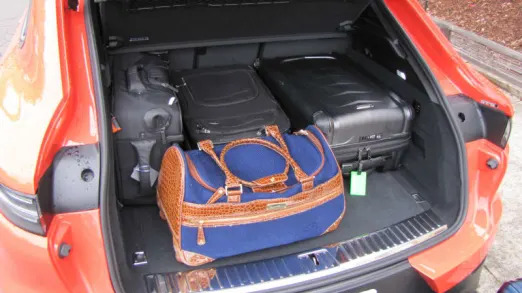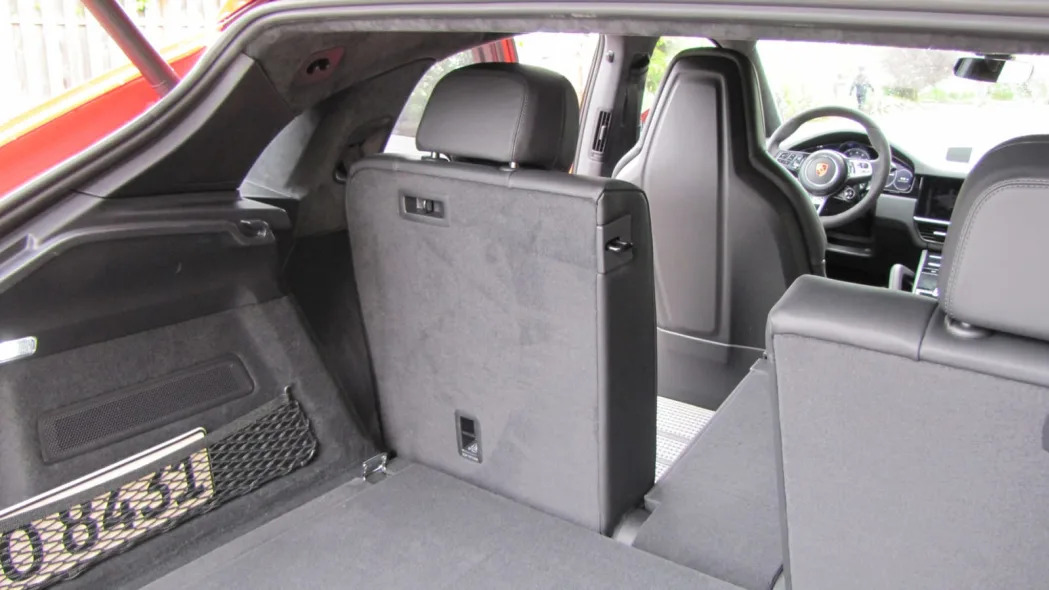There are typically two practical drawbacks to a sport utility "coupe." One is reduced backseat space and comfort resulting from a lowered roof and usually a lowered seat bottom to counteract the lowered roof. As noted in the video walk-around of the 2020 Porsche Cayenne Coupe Turbo S E-Hybrid yesterday, however, its lowered roof and back seat don't make a substantial impact.
The other potential drawback is cargo space, which is what we'll be testing here. According to Porsche's specs, the regular Cayenne has 22.7 cubic-feet of space behind its raised back seat, while the Cayenne Coupe has 17.6. That's a difference of 5.1 cubic-feet, which can be fairly significant — that's pretty much what my 1998 BMW Z3 trunk has, and I'm perpetually surprised by how many grocery bags I can stuff back there.
Unfortunately, I never luggage-tested the regular Cayenne Turbo I drove last year, but it's also pretty obvious how its extra cargo area height would make a difference.

To begin, I'll keep the large, rigid cargo cover in place. With it, you're really just looking at a very accessible trunk.
And for the boilerplate bit, as always, I use two midsize roller suitcases that would need to be checked in at the airport (26 inches long, 16 wide, 11 deep), two roll-aboard suitcases that just barely fit in the overhead (24L x 15W x 10D), and one smaller roll-aboard that fits easily (23L x 15W x 10D). I also include my wife's fancy overnight bag just to spruce things up a bit (21L x 12W x 12D).


The four smallest bags can be lined up on their sides, leaving plenty of room for an extra pair of small duffels or grocery bags. There was no way to fit the two largest bags.
Alternatively, above right, you can fit one of the big bags in place of the smallest roller.

OK, let's take off the cargo cover, which is gigantic.

So all the bags fit, but this took a LOT of effort. This was the last of maybe eight different Tetris permutations I tried to get all the bags to fit without stopping the liftgate. There was much racket and swearing.
This was far more difficult than with, as one example, the Mercedes GLC. That has 19.4 cubic feet, and judging by the pictures, I'd say that numerical disparity between them is accurate.
Now, you can add some space here by adjusting the seatback. I wouldn't really deem this a "reclining" seat back since the aft-most position is pretty much just a regular, comfortable rake. As you can see, the seat's raised to its most upright position, your backseat passenger sure wouldn't want to go far sitting at a near 90-degree angle. In this way, the Cayenne Coupe can be exactly like a 911!



You can see how much space you gain by doing this, but then doing so also torpedoes the notion that the Cayenne Coupe's back seat isn't that affected by the different body style. Not a bad thing to have the option, though.
So, the Cayenne Coupe is most definitely less practical than its regular sibling. Having a boxier cargo area would've made jamming all those bags in so much simpler (I'm guessing it would be pretty similar to the Range Rover Sport). That said, all those bags did in fact fit, which means that the Cayenne Coupe has more space than its 17.6 cubic-foot number would indicate. It was the same situation with that Mercedes GLC and the Alfa Romeo Stelvio. Whatever measurement method those companies utilize basically shortchanges their vehicles relative the competition. A 17.6-cubic-foot cargo area should be akin to subcompact SUVs and hatchbacks that wouldn't come close to swallowing all this luggage.
Related Video:


Sign in to post
Please sign in to leave a comment.
Continue